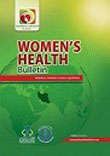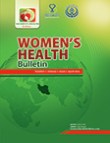فهرست مطالب

Women’s Health Bulletin
Volume:3 Issue: 4, Oct 2016
- تاریخ انتشار: 1395/07/12
- تعداد عناوین: 7
-
-
Page 2BackgroundBurnout is a leading cause of physical and psychological injuries and evaluating the relationship between the self-efficacy and burnout of nurses could provide new knowledge on the organization of the subject.ObjectivesThe aim of this study was to determine the relationship between self-efficacy and burnout among nurses in Behbahan city, Iran, in 2014.MethodsIn this cross-sectional study, 151 nurses were randomly selected from 3 hospitals in Behbahan city proportionate to their staff number. Data were collected using the Maslach burnout and the Scherer self-efficacy questionnaires. Data were analyzed using ANOVA, t-test and Spearman correlation coefficient by SPSS software version 16. PResultsFrom a total of 151 nurses, 39 cases were male and 112 were female. The mean age was 33.5 ± 8.7 years and the mean of self-efficacy was 60.89 ± 6.58. Most nurses had low burnout in the subscales of depersonalization (63.6%) and emotional exhaustion (64.2%); however, regarding lack of personal accomplishments most of them (65.6%) reported higher levels of burnout. The results also showed a significant and inverse difference between the self-efficacy and three dimensions of burnout, depersonalization (PConclusionsThe findings of the present study show that increasing self-efficacy among nurses can lead to a decrease in burnout in the subscales of depersonalization, emotional exhaustion, and lack of personal accomplishment. Adopting strategies for increasing the self-efficacy would help reduce the burnout and increase motivation and satisfaction among nurses.Keywords: Self, Efficacy, Burnout, Nurses
-
Page 3BackgroundInfertility is becoming a world-wide concern in developed and developing countries. Multiple causes are responsible for the situations and various therapies have been developed to overcome this problem in infertile couples, as in the case of intrauterine insemination (IUI), with considerable variations between pregnancy rates in relation to the method employed.ObjectivesTo compare pregnancy rate, by human chorionic gonadotropin (HCG) administration and urinary luteinizing hormone (LH) surge method, for insemination in patients undergoing IUI.
Patients andMethodsThe present study included 309 infertile women, candidate for IUI, randomly divided into LH surge and HCG groups (each participant was assigned a number from 1 to 309, of which odd numbers were for LH and even numbers for HCG groups, respectively). All patients were subjected to baseline ultrasound and received clomiphene citrate before undergoing serial transvaginal sonography. The LH was measured using LH kit, when 2 - 5 follicles (18 - 20 mm) appeared in LH surge group, and, if positive, IUI was performed after 24 hours. In HCG group, the patients received HCG 1000 units and underwent IUI after 36 hours. The pregnancy rate was then compared in LH and HCG groups.ResultsWe found no significant differences in pregnancy rates between the two groups. Also, we compared pregnancy rates between the two groups based on age, infertility cause, number of follicles, number of previous IUI and previous abortions. We found no significant differences between the subgroups, in terms of pregnancy rate.ConclusionsThe urinary LH surge and HCG administration methods for IUI timing are similar and none had any considerable advantages over the other. However, the use of the urinary LH surge has no side effects or injection pain, in relation to HCG administration methods.Keywords: Chorionic Gonadotropin, Clomiphene Citrate, Luteinizing Hormone, Insemination, Artificial, Pregnancy -
Page 4BackgroundExercise can play a major role in health during pregnancy. Therefore, it is essential to consider the physiological conditions of females regarding the exercise.ObjectivesThe present study aimed to determine the effect of a cycle of exercises on pregnancy outcomes.MethodsIn this clinical trial, 120 pregnant females referring to Shiraz hospitals in 2015 were randomly divided into the intervention and control groups. The intervention group subjects were required to do aerobic exercises for eight weeks since the 20th week of gestation in addition to receiving the routine care. However, mothers in the control group only received the routine pregnancy care. Then, pregnancy outcomes such as length of pregnancy, delivery phases, type of delivery and infants physiological indexes such as Apgar score, weight, height and head circumference were measured. Finally, the data were transferred into the SPSS statistical software and analyzed using T-test and Chi-square test.ResultsThe two study groups were similar based on their age, level of education, income, employment status and satisfaction with their husbands. Also, no significant difference was observed between the two groups regarding the length of pregnancy, weight, height and Apgar score at birth. However, a significant difference was observed between the two groups concerning type of delivery, duration of active phase of delivery and pain intensity in the active phase of delivery. In addition, back pain intensity significantly decreased in the intervention group, but increased with progress in pregnancy in the control group.ConclusionsSpecial attention is paid to supportive methods such as exercising during pregnancy in the recent years. Exercising has positive effects on mothers and infants health. Thus, these exercises are recommended to be incorporated in pregnancy care..Keywords: Aerobic Exercise, Pregnancy, Infant Weight, Duration of Pregnancy, Apgar Score, Type of Delivery
-
Page 5BackgroundMetabolic syndrome is considered a risk factor for many chronic diseases, such as type II diabetes and cardiovascular diseases (CVD). The syndrome is the result of various factors, including poor nutritional diets, sedentary lifestyles, and genetic predisposition. Physical activity and good nutrition can prevent metabolic syndrome.ObjectivesThe aim of the present study was to compare the effects of continuous and discontinuous training on metabolic syndrome components in non-athlete, middle-aged woman.
Patients andMethodsForty-five non-athlete women who met the study criteria voluntarily participated in this study. The participants were divided randomly into three groups: continuous, discontinuous, and control (n = 15 in each group). Twenty-four hours before the beginning of the training program, a blood sample was obtained from each participant in the fasting state .The two training groups participated in sports activities designed to produce a heart rate of 50 - 70 beats/minute for 8 weeks, three times a week, for 60 - 90 minutes. The continuous training group performed the activities in one session, and the discontinuous training group performed them in two sessions, for the same time and intensity. Twenty-four hours after the completion of the 8-week program, all the measurements were performed similar to the pretest phase. The data were analyzed using a one-way analysis of variance (ANOVA).ResultsThe discontinuous training significantly decreased each participants weight (P = 0.04) and systolic blood pressure (BP) (PConclusionsThis study demonstrated that a regular physical activity program in the form of discontinuous training improved metabolic syndrome indexes in non-athlete, middle-aged women. Discontinuous training seems to be an efficient, safe, and inexpensive way to reduce and prevent metabolic syndrome.Keywords: Exercise, Women, Metabolic Syndrome -
Page 6BackgroundInfertility is a multi-aspect problem; it can cause major disturbances with emotional, social and psychological consequences including loss of life satisfaction. Spirituality is considered as an important source for individuals to adapt with stressful life events.ObjectivesThe current study aimed to determine the relationship between spiritual well-being and life satisfaction in females with infertility.MethodsAfter explaining the study goals to the subjects and attaining their written consents, the present cross-sectional co-relational study was conducted on 190 females with infertility referred to Isfahan fertility and infertility center, Isfahan, Iran. The subjects were selected through a convenience random sampling method in three months by the satisfaction with life scale (SWLS) and spiritual well-being scale (SWBS) through face to face interview in 2013. Data were collected and then analyzed by SPSS ver. 17. Descriptive statistical methods (frequency distribution, mean, variance and standard deviation tables) and analytical statistical methods (Pearson correlation test, Spearman correlation coefficients, one-way ANOVA and T-test) were used.ResultsThe results of the study indicated a direct relationship between the scores of life satisfaction and religious dimension of spiritual well-being (r = 0.375, PConclusionsThe present study showed that people with higher spiritual well-being had a higher life satisfaction. Since infertility has numerous social and psychological complications and consequences, which can lead to lower life satisfaction, the medical staff can increase spiritual well-being and life satisfaction in females with infertility problems by taking proper measures and actions.Keywords: Females With Infertility, Spiritual Well, Being, Life Satisfaction, Iran
-
Page 7BackgroundIn the recent years, spirituality and its effect on peoples health have become a subject of interest. Identifying the factors related to spiritual well-being, especially for students as the educated class and future decision-makers of the society, is very important.ObjectivesThe present study was carried out in order to determine the relationship between spiritual well-being and self-efficacy in students of Isfahan University of Medical Sciences.MethodsThis descriptive-correlational study was carried out during year 2014. One-hundred and seventy-five students of medical, health and modern science technology colleges of Isfahan University were selected by random sampling. The data was collected via demographic specification, spirituality well-being and self-efficacy questionnaires, and the information was analyzed by the SPSS software using descriptive statistics, t-test, Pearson and regression correlation coefficient. The significance level was considered lower than 0.01%.ResultsIn total, 175 students including 75 males and 100 females participated in the study. The mean age of the participants was 23.8 ± 0.29 years. About 70% of the students were single and the remaining were married. With respect to education, 47.7% had Bachelor of Science (BS), 28.4% had Master of Science (MS) and the remaining were PHD students. The mean score of the students under study was 97.5 and the mean score of self-efficacy was estimated as 33.41. There was a positive significant relationship between spiritual well-being and self-efficacy (R = 0.41 and PConclusionsIn the present study, spiritual well-being had a direct relationship with self-efficacy. As for the importance of spirituality in mental health, it is suggested to make arrangements in order to promote self-efficacy in students.Keywords: Spirituality, Health, Student, Self, Efficacy


